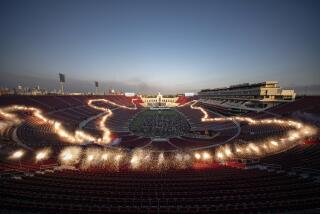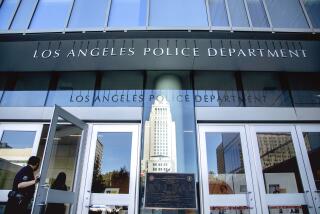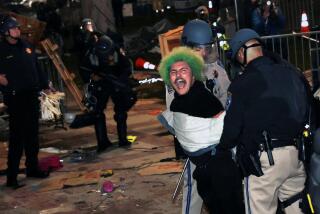Bullets Fired at Sky Cited in 38 Deaths : Study: Hospital lists holiday data over seven years. Police question it.
Bullets fired into the air during raucous Independence Day and New Year’s Eve celebrations have maimed and killed a surprisingly large number of Los Angeles residents, according to physicians at King/Drew Medical Center.
From 1985 through 1992, 118 people were treated at King/Drew for such injuries on those holidays and 38 of them died, Dr. Gary J. Ordog and his colleagues reported recently in the Journal of Trauma. A full 75% of the survivors suffered severe long-term disabilities, the doctors reported, including paraplegia, quadriplegia, seizures and chronic pain.
There is some skepticism about the numbers reported by the King/Drew team. The Los Angeles County Sheriff’s Department and the Los Angeles Police Department--which serve a vastly larger area--reported only about half a dozen deaths in the same period.
“They may have had different criteria in determining whether the gunshots were random,” Ordog said Thursday. “But it’s not the absolute numbers that are important, but the fact that people can be seriously injured or killed by such gunshots.”
The mortality rate from such random shootings, about 32%, is much higher than the 2% to 6% normally associated with gunshot wounds, Ordog said. That is probably because 77% of the victims were hit in the head, which is especially vulnerable to gunshot wounds, he added.
The male/female ratio of the victims was significantly different from that for normal shootings, as well. Only 62% of the victims of bullets falling from the sky were male, and males normally account for 92% of gunshot wounds, he said.
Ordog, an emergency room physician, and his colleagues used three primary criteria in identifying victims of what he calls “space bullets”--from the shooters’ mistaken belief that such projectiles go into space and never return to the ground:
* The victim or witnesses did not hear a gun fired.
* The victim or witnesses did not see anyone with a weapon near them.
* The wound was consistent with a bullet falling from the sky--usually on the top of the head, shoulders or upper back when the victim was standing.
Police, he said, often insist on identifying the shot’s source before categorizing a victim as having been struck by a random gunshot.
The incidence of injuries is about the same on the two holidays, Ordog noted. On a typical Fourth of July or New Year’s Eve, “we probably see three or four,” he said.
The experience reported by King/Drew is different from that of other hospitals in the region. Dr. Deirdre Anglin, an emergency medicine specialist who has spent many New Year’s Eves at County-USC Medical Center, said, “I personally have never seen somebody who was struck by a bullet going up and then coming down, although it clearly does happen.”
Other hospitals contacted by The Times also reported few cases. Ordog, however, noted that King/Drew sees more than half of the gunshot victims in Los Angeles County, about 4,000 a year. “That’s far more than any other hospital,” he said.
When a bullet is fired into the air, air resistance slows it about 60 times as fast as does gravity. A typical slug, fired at a velocity of about 2,700 feet per second, will climb about two miles high before beginning its descent and will stay in the air more than a minute. The speed of descent depends upon its orientation and weight.
Most bullets are still spinning when they reach the top of their flight and descend base-first, exposing a broader area to air resistance. A .30-caliber bullet falling in this orientation will reach a steady speed of about 300 feet per second, while a heavier .50-caliber machine gun bullet will reach 500. If they are falling point first, their speeds can be 50% higher.
Many previous studies have shown that a speed of only 100 feet per second is necessary to penetrate the skin and 200 feet per second is sufficient to break bone and penetrate the skull.
(BEGIN TEXT OF INFOBOX / INFOGRAPHIC)
Bullets in the Sky
Between 1985 and 1992, 118 people were treated there for such injuries at King/Drew Medical Center for injuries related to falling bullets; 38 died. In recennt years, law enforcement officials have made a special effort to discourage residents from shooting guns in the air during the New Year’s and Fourth of July. After being fired vertically, bullets will usually fall base-first or tumbling, landing at twice the speed of a major league fastball. Shots fired at angles of substantially less than 90 degrees are more likely to fall point-first and at higher velocities.
Path of .30-06 bullet shot upward and decending point-first. Velocity (ft./sec.): 2,700 Elevation: 0 degrees Time (seconds): 0
*
Velocity (ft./sec.): 825 Elevation: 4,488 degrees Time (seconds): 3.5
*
Velocity (ft./sec.): 0 Elevation: 10,120 degrees Time (seconds): 21
*
Velocity (ft./sec.): 412 Elevation: 5,758 degrees Time (seconds): 39
*
Velocity (ft./sec.): 457 Elevation: 0 degrees Time (seconds): 53
Source: National Rifle Assn, King/Drew Medical Center
More to Read
Sign up for Essential California
The most important California stories and recommendations in your inbox every morning.
You may occasionally receive promotional content from the Los Angeles Times.










